Plasterboard ceilings for the hall: varieties, choice, interesting solutions

Special attention is paid to the design of the ceiling space today. And this is no accident: a beautiful ceiling significantly increases the status of the interior. It is especially important that it be beautiful in the living room - a place where households and their guests gather. In the article, we will consider the types of plasterboard ceilings, note the nuances of choosing the optimal design and the features of choosing an option for a specific interior style.


Advantages and disadvantages
Plasterboard is a lightweight sheet format building material. It is based on lightweight gypsum, supplied with special additives. Thanks to this feature, drywall has flexibility, which allows it to take the desired shape. On both sides, the gypsum is decorated in special construction paper, while the ceiling sheets are thinner than the wall sheets.
These systems can play up the disadvantages of a particular hall's perspective, giving them the appearance of design features.... For example, in a living room, this can be a design divided into several zones with different heights and shapes.
Sometimes the design provides for the transition of the sheet to the wall, which looks unbroken and fresh.






In addition, ceilings made of this material have many other advantages.
- They are characterized by optimal weight, so they do not create a large weight load on the walls and ceiling. This allows you to create not only simple, but also complex design solutions.
- Sheets may vary in size, but during operation they do not deform or sag.They are perfectly attached to the frame and do not bend after they have been given the desired shape.
- The material allows different technologies for installing ceiling structures. Today it can be built on a metal and wooden frame, and in some cases, glued to a prepared base.
- Drywall has excellent technical and operational characteristics. It is durable, fire and moisture resistant, has soundproofing properties, which is especially important for residents of apartment buildings.
- Plasterboard ceilings look aesthetically pleasing. Their design can be laconic and complex, indicating that they belong to a particular interior style.
- The material goes well with other types of ceiling materials (slats, foil, panels). This allows you to diversify the design of the ceiling space, to make it unique.
- In most cases, when installing plasterboard ceilings, it is not necessary to prepare the base. This significantly saves installation and installation time.
- It is not difficult to work with drywall: such ceilings can be installed independently, without involving outside specialists. It won't take long to master the technology.
- Plasterboard ceiling structures are not limited in color, the material can be painted in any shade that the customer likes.
- Plasterboard is undemanding for the installation of fixtures. You can decorate such a ceiling with a wide variety of lighting devices. Both chandeliers and spotlights are easy to mount in it, it does not melt.
- Plasterboard ceilings are often tools for design space zoning. This is especially convenient for organizing the living room, brings order to it.
- The material can be decorated not only with internal and hidden lighting, but also with moldings, stucco molding, painting, baguette. Its installation allows you to hide the unevenness of the walls in height.






In addition to the advantages, plasterboard ceilings for decorating a living room or hall have several disadvantages.
- Frame systems reduce the height of the walls, which is bad for installing structures in small apartments with low ceilings (less than 2.5 m).
- Simple systems are easy to make, for complex design solutions you will have to use the services of a specialist.
- The material is malleable, but with incorrect and inaccurate calculations of the structure, it can crack or bend.
- An excessively deep fastening of the clamps can lead to their sinking into the sheets, which impairs the aesthetics of the design.
It is undesirable to use a wood frame, since over time the wood can deform.






Types of structures
Euro plasterboard ceilings can be different. They can be conventionally classified by the number of levels. Based on this, then they are:
- single-level;
- two-level;
- three-level;
- multilevel.
Sibling options are considered the simplest. In fact, these are sheets of drywall, stitched together, which together make up a solid canvas. Two-level are distinguished by a design of the so-called two steps. In addition, the second levels can be shapes attached to the first. Three-level and multi-level are performed, forming a larger number of frame steps. In this case, the installation starts from the lower tiers.
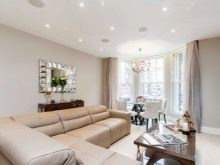


The manner in which plasterboard ceiling structures are executed in the living room can also vary. Design options are linear, frame and curly... By visual effect, the design can be zonal or soaring. Zonal imply a design with an accentuation of a small section of the ceiling. Floating counterparts have an unusual effect, in which it seems that the ceiling is hanging in the air.
False ceilings are called because of the fastening technology in which suspensions are used. Floating structures are distinguished by the possibility of rotation. As a rule, these are small accents, the shape of which can be square, rectangular or round. Often, these systems are supplemented with their own built-in lighting.



Linear modifications are standard solutions using straight lines and shapes in design. Framework analogs differ in appearance. In fact, these are boxes, inside of which a material contrasting in color or texture is inserted. For example, it can be the so-called combined design techniques, where drywall is supplemented with a stretch film.
Shaped ceilings imply the use of wave-like, curved lines and cut-out shapes in the design without a craving for geometry.... Lines of curly ceilings can be zigzag or consist of a combination of smooth contours with huge shapes cut from sheet ceiling plasterboard.

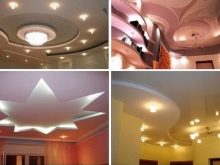

Color spectrum
Color solutions for plasterboard ceilings can be very diverse. However, in a living room, it is more necessary to take into account the color ability of creating an atmosphere of a home. For this reason, in living rooms, it is customary to avoid an abundance of dark colors and negative color combinations. It has been scientifically proven that dark tones bring a certain amount of discomfort to the interior of any home.
The best tones for ceiling decoration are considered white and light pastel colors. The relevance of white is explained by its ability to take on the emotional coloring of the color with which it is combined. It is versatile and suitable as a softener even for a dynamic interior color chosen as the basis for furnishing a living room.
White color visually increases the height of the walls, erases the rigid boundaries of the room, saturates the room with light and air.


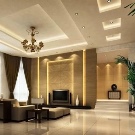



Black is appropriate for small expressive strokes. There should not be much of it in the color scheme of the ceiling space, as well as poisonous red or sharp orange. To create a welcoming and positive atmosphere in the interior of the guest room, you can select design options in light and muted colors. They look noble, do not draw all the attention to themselves, but at the same time significantly increase the status of the interior.



Ideal tones when choosing a color can be beige, milky, creamy, ivory and bleached peach... Warm shades are appropriate in a room with north-facing windows. For a southern living room, cool tones are more suitable. The ceiling of a light coffee with milk color and a shade of cocoa looks beautiful in the interior of the hall.



Blue, purple tones are considered difficult, when choosing them you will have to pay a lot of attention to the selection of "softeners" so that the interior composition does not seem gloomy... The ceiling should not visually press on household members or guests. If you choose dark tones, then they must be diluted with light contrasts.
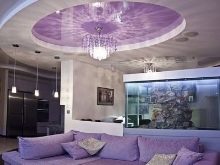


If the owners want something interesting, you can choose option in white and complement it with a hidden RGB LED strip. Depending on what tone of light flux the household chooses, the ceiling will change its color.

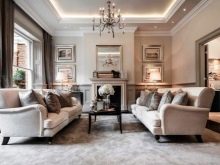

Style solutions
The style of the home interior is the key criterion that often prompts the type of ceiling design. In the living room, like any other room in an apartment or a private house, the style can be very diverse. To understand how to choose the right option and not be mistaken, you need to build on the resources of a specific direction of interior design.
For example, classic style brancheswhich include classic, neoclassic, classicism, need a deliberate elegance. Here it is important to point out the high cost, high status, a kind of palace solemnity. They embody such solutions in living rooms of a large area, since in a limited space, pomp is simply inappropriate.
This is necessarily symmetry in the design, the apparent severity of the lines, the combination of drywall with a stretch film, the use of light shades of the color palette.



The design should not be laconic: everything should indicate that respectable people live in the dwelling. The required design attribute must be massive chandelier. The design can be frame, with each corner of the plasterboard box decorated with gilding or moldings. The use of stucco decoration is encouraged, but a combination with photo printing on film is undesirable in this case: manufacturability is not a true sign of a classic interior.
Modern design branches, on the other hand, are literally imbued with the atmosphere of modernity. Such a design should seem simple, but in reality be smart. However, the elegance of, say, styles minimalism, modern, art deco, brutalism differs from the classics. Here should not give off a kind of bourgeoisness.
It is important that the decoration is simple but tasteful.



For example, it can be a contrast of neutral colors, which today is considered one of the fashionable solutions in choosing a ceiling design. For styles that adhere to minimalism, it is important to remove everything unnecessary from the design, because it will be possible to decorate it with the same functional lamps. This is more than enough in a space that is alien to everything pompous (for example, minimalism).
The design of the ceiling in the Art Nouveau style, in contrast to the straightforward and rustic minimalism, cannot be one-level. Curly and soft shapes are welcome here, the mandatory use of built-in and often hidden backlights (including inside the film when combined with drywall).


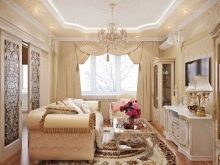
Design options
The modern approach to plasterboard ceilings can vary greatly. Each new season, interior designers offer a lot of stylistic design innovations. For example, you can decorate the ceiling with various patterns, if this does not contradict the trends of a particular style direction. And also it can be, for example, a drawing drawn with the help of special paints in the subject of interior stylistics. In some cases, it can move to the accent part of the wall for a specific functional area of the living room.





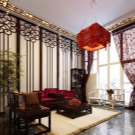
Besides, it is possible to orient the design to accentuate any figure. For example, curved lines, circles indicated by an LED strip look good on the ceiling. Often, in 2-tier structures, it is the tape that creates a unique design, marking the boundaries of one of the levels and drawing more attention to the central lighting device. It goes well with panels (wall lights), spotlights and spotlights.
The design can be a frame ceiling with the addition of a geometric or fantasy figure on one of the sides of the box. Wherein in most cases, such figures are emphasized with point lighting fixtures and tape.
It is also possible to use abstract patterns from elements of the ceiling composition cut out according to a specific shape.




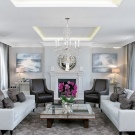

As for the accentuation of small figures in the design of drywall structures, then design can be both laconic and complex (using hovering hinged systems). Someone highlights the chandelier, creating ornate and abstract figures, others cut petals out of drywall, accentuating the chandelier with their help. Often the emphasis is on the use of stretch film.
In this case, the elegance of the ceiling can be given by choosing a contrasting color of the film material or by photo printing, texture, by embedding optical fiber and LED strip inside the film. The effect of such ceilings is amazing: they seem voluminous and are able to give high status to any interior.However, everything can be spoiled by choosing a pattern: neither huge flowers nor soaring giant pigeons will create a comfortable atmosphere in the hall.
However, stylized ornaments around the edges of the film would be quite appropriate, as would a starry sky created with fiber optics.



How to choose?
To choose the best design option for a plasterboard ceiling, it is worth considering a few nuances.
- For a living room of a small area, they select a design option without unnecessary decoration. It is necessary to follow the rule "smaller room - simpler design".
- For a room in an apartment with a high ceiling, you can choose a two-level or three-level type of ceiling. If the room is large, one of the living room zones can be designated with a special figure.
- The backlighting is selected based on stylistic resources. If chandeliers and candelabra are needed for the classics, spots, spotlights, panel lamps and tape are more appropriate in modern design.
- The type of room is important: for a square ceiling, zonal division is necessary to create the visual effect of lengthening. A narrow rectangular one needs to be diluted with decor on the sides, getting rid of the effect of visual imbalance.
- In a house with a two-level living room, the design can be complex multi-level. This will not affect the ceiling height as noticeably.
- The color of the material should not be dark, as dark shades visually steal the height of the walls. In addition, the darkness on a subconscious level puts pressure on the household.
- The area of the hall matters: 16 and 18 sq. m allow you to create a design that uses only one accent. In this case, it is better to avoid visual emphasis of the entire ceiling sheet.
- If the furniture is planned to be placed against the wall, the accent can be made over this area. For example, it can be a semicircle design, complemented by spotlights.
- If you want to designate a TV zone, you can create a backlit figure by making its transition to the wall on the sides of the video zone. The shape of the figure can be different.
- In a studio layout, it is worth highlighting the ceiling above the guest area. At the same time, other functional islands must be supplemented with their own lighting devices.
- The backlight, in addition to the style solution, is selected taking into account the installation possibilities. Embedding fiber and LED strip under a stretch film in a drywall box or a figure can only be done by a professional.
- Drawings and patterns are appropriate where there is space, and in a limited space, large figures and patterns do not look attractive. Stucco molding is not used in minimalistic styles.
- When choosing a design with a pattern on a stretch film, texture is also important: the gloss gives glare when illuminated, so that part of the pattern will not be noticeable when the light is on.

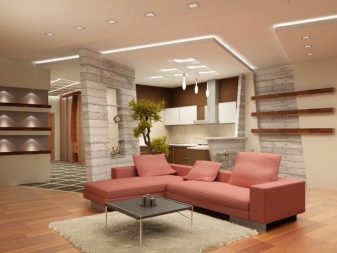
Beautiful ideas
Nothing explains the design possibilities of plasterboard ceilings better than illustrative examples.
- Plasterboard ceiling decoration for a large hall.

- Ceiling accentuation of the sitting area in the living room.

- Ceiling with stretch film in contrasting color.

- An option for decorating the ceiling space in a bright living room.

- Zone design using LED strip.
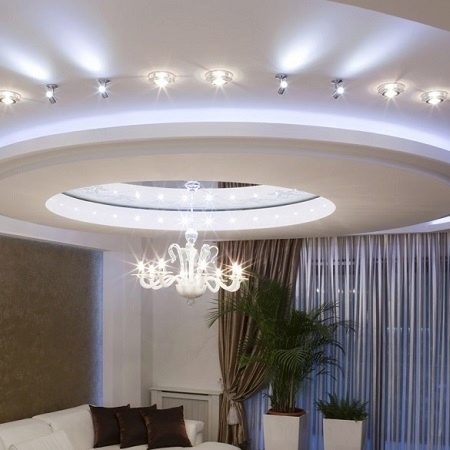
- Decoration of the ceiling area with soft lines.

- Accentuation of the central lamp in the interior of the living room.
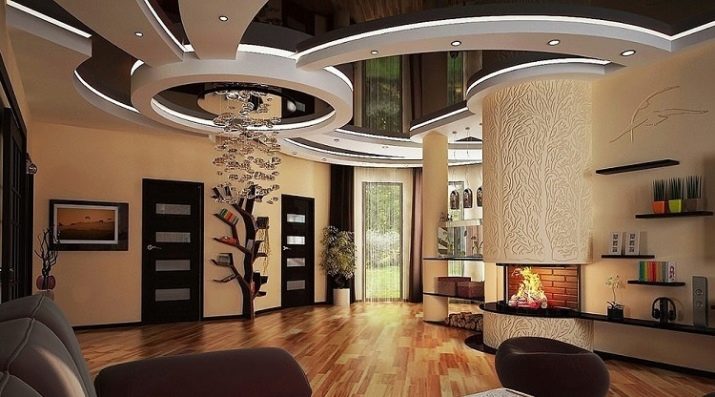
- Ceiling design with illuminated guest space.

- The choice of decoration for a room with a TV area.

- Using interior lighting to accentuate the ceiling.

For information on how to make a drywall ceiling with round sides with your own hands, see the next video.








